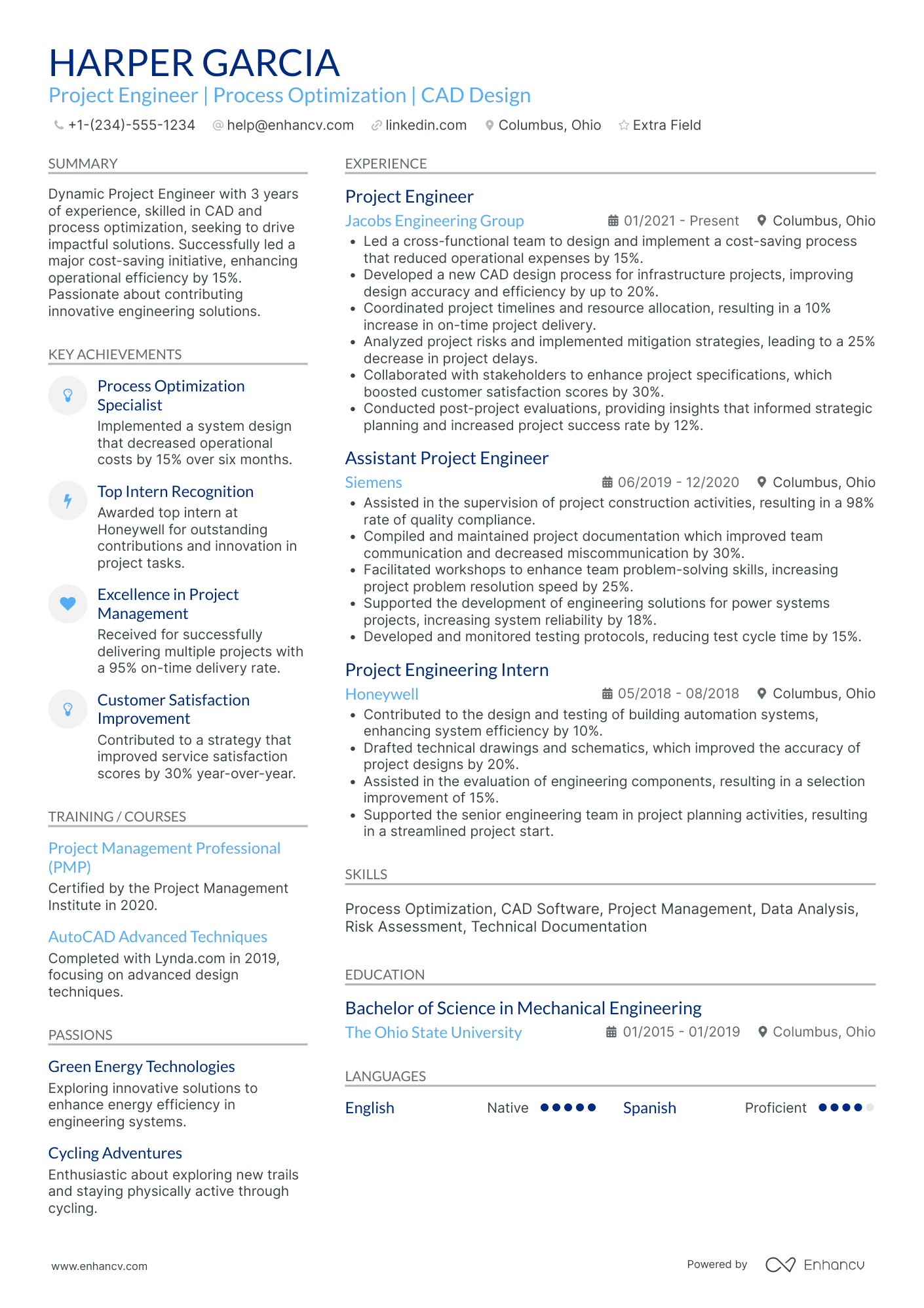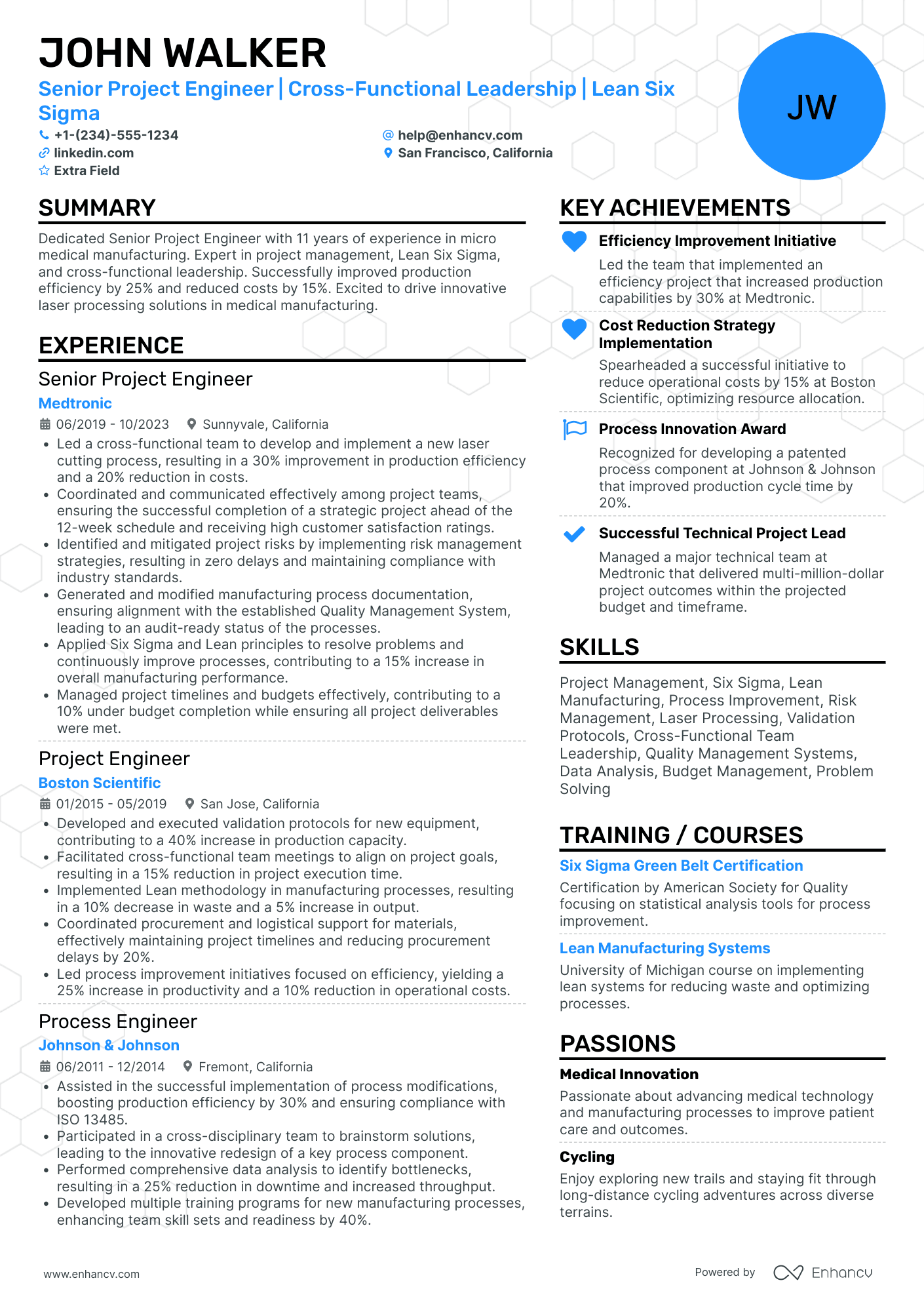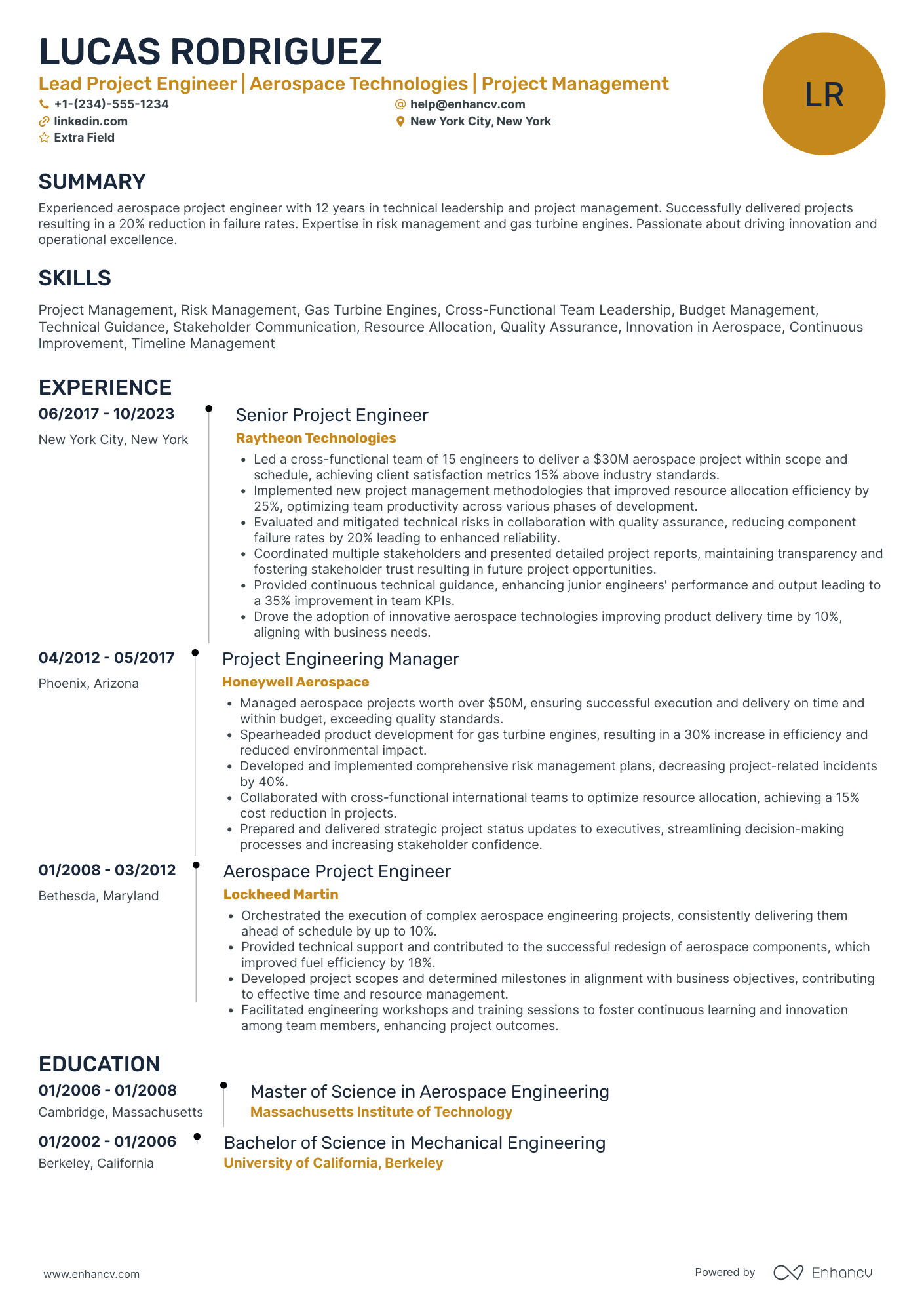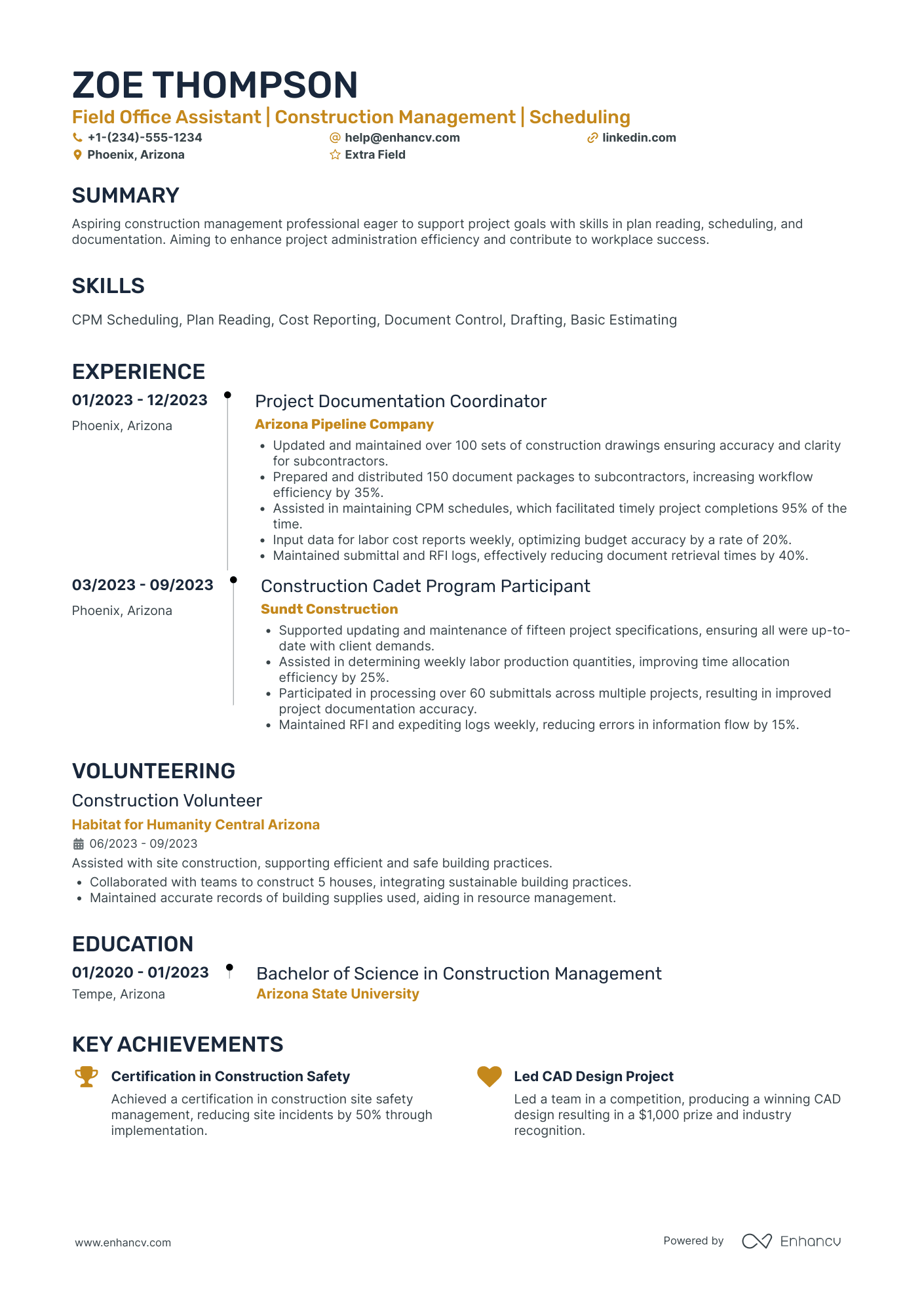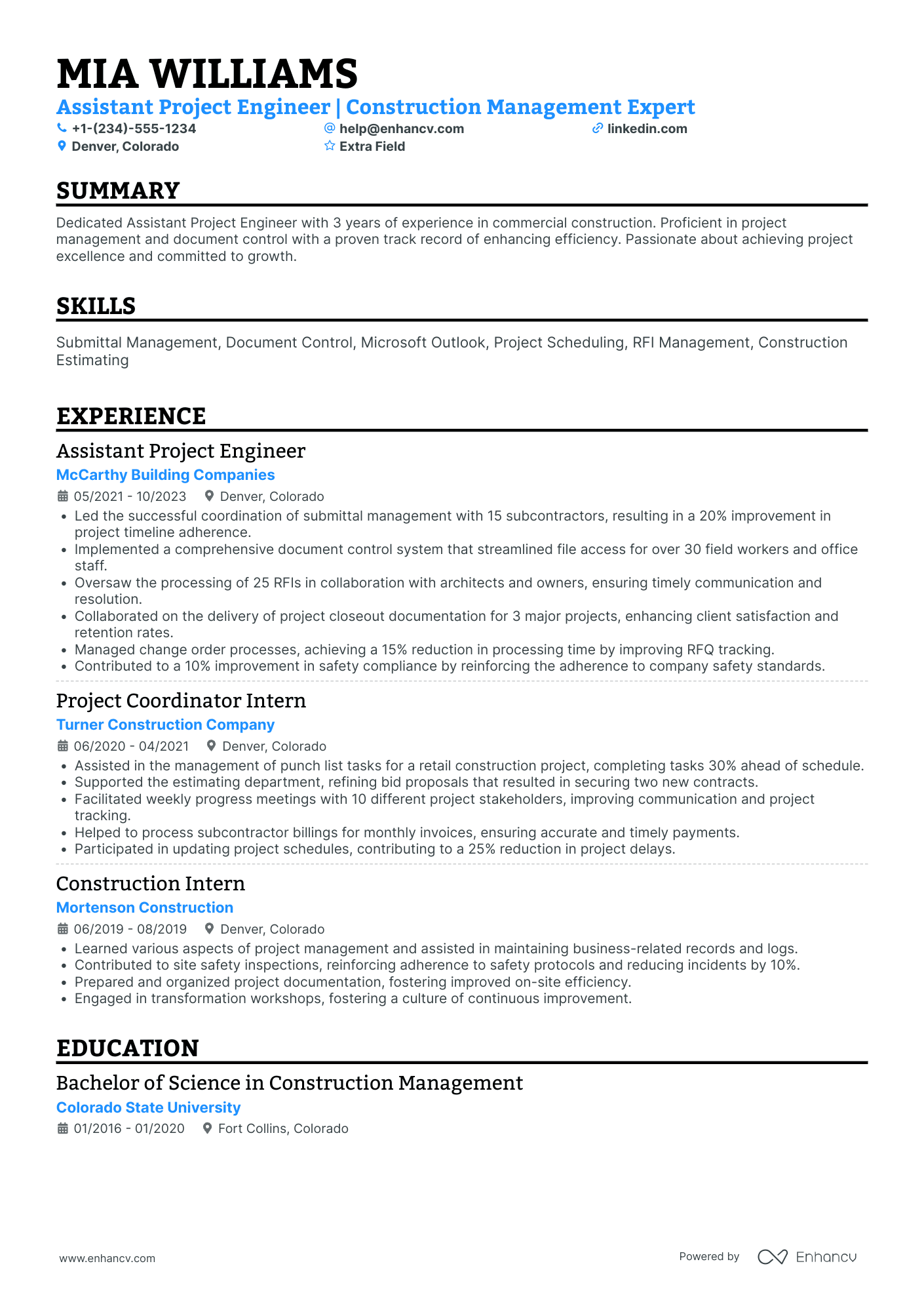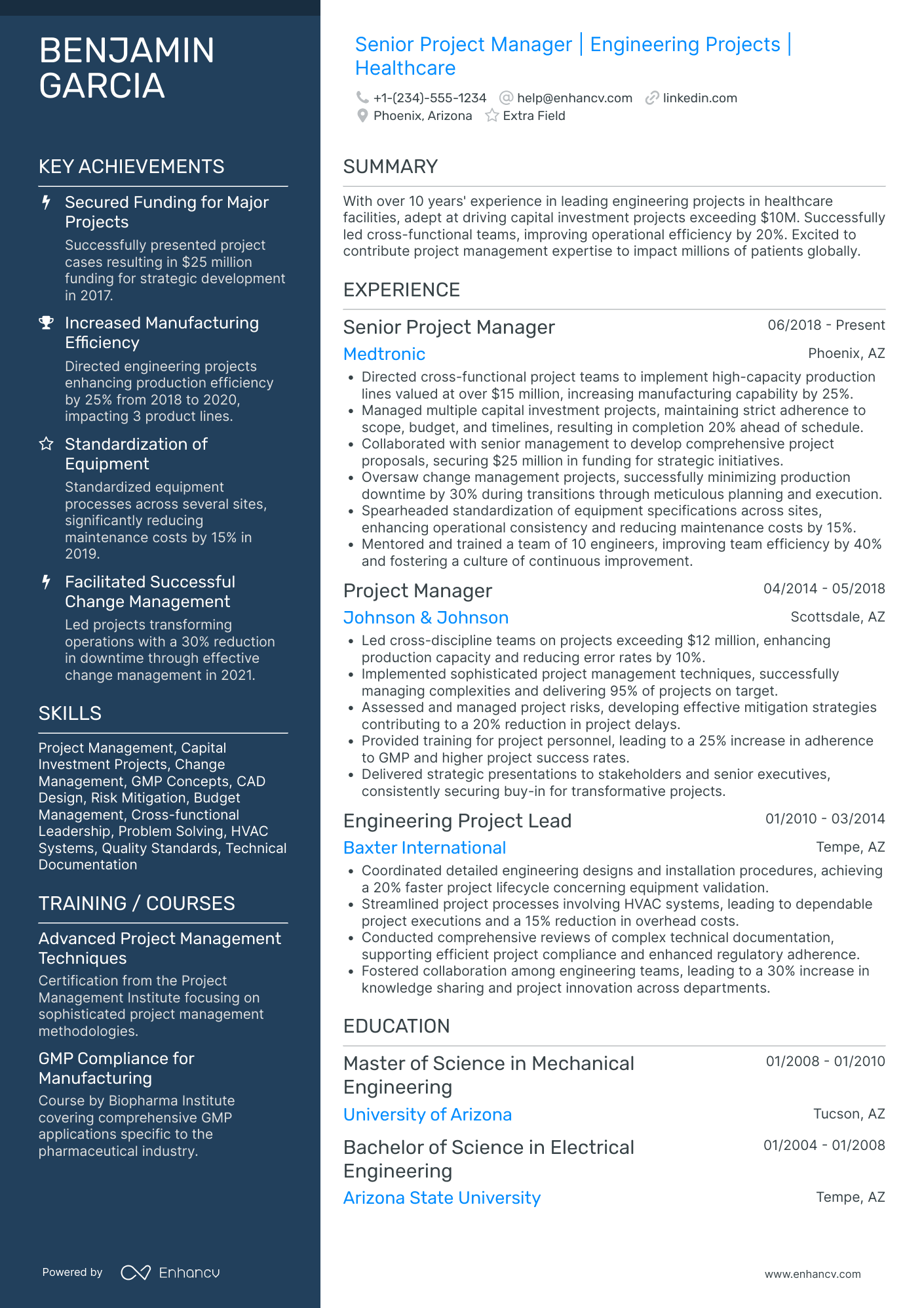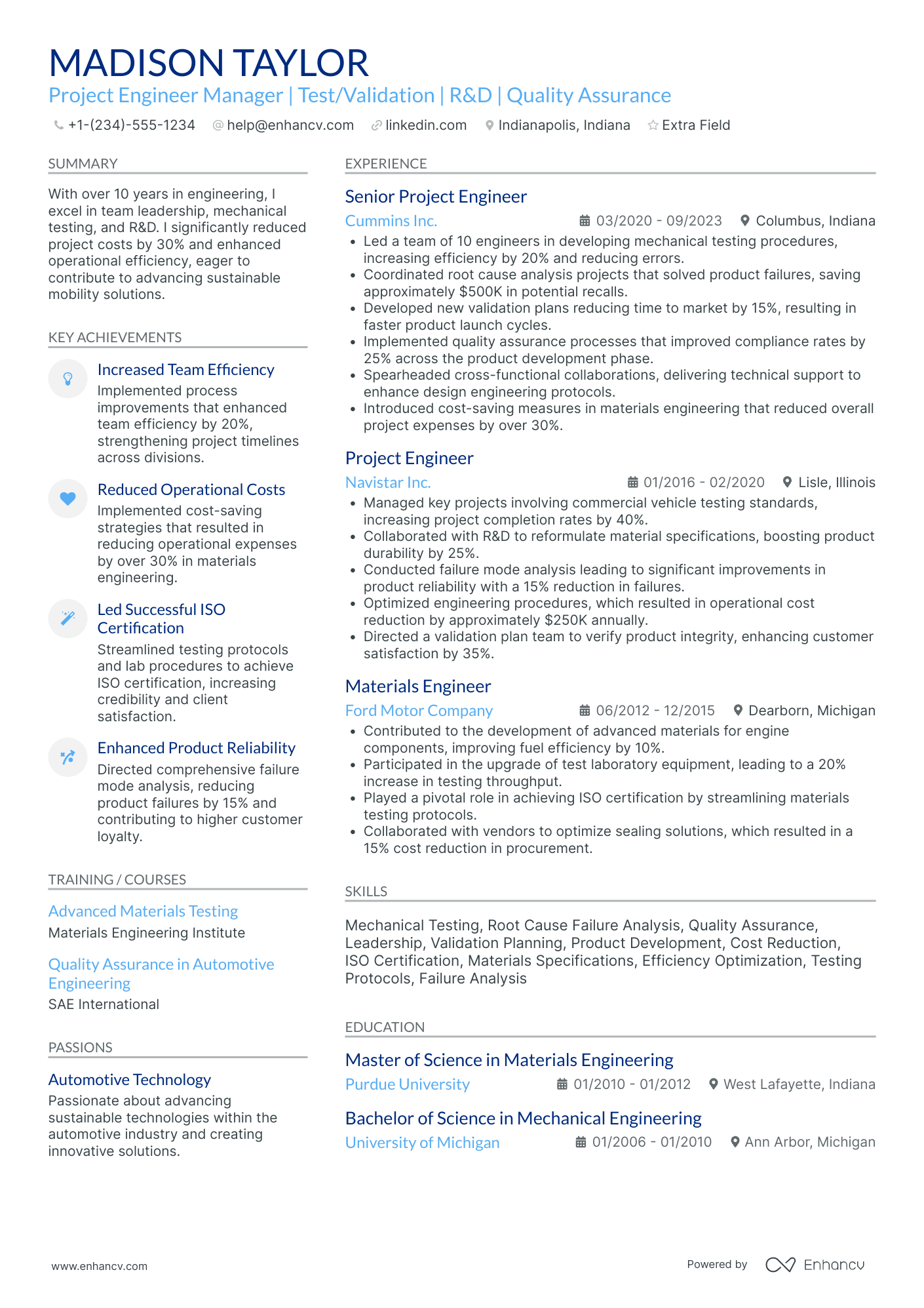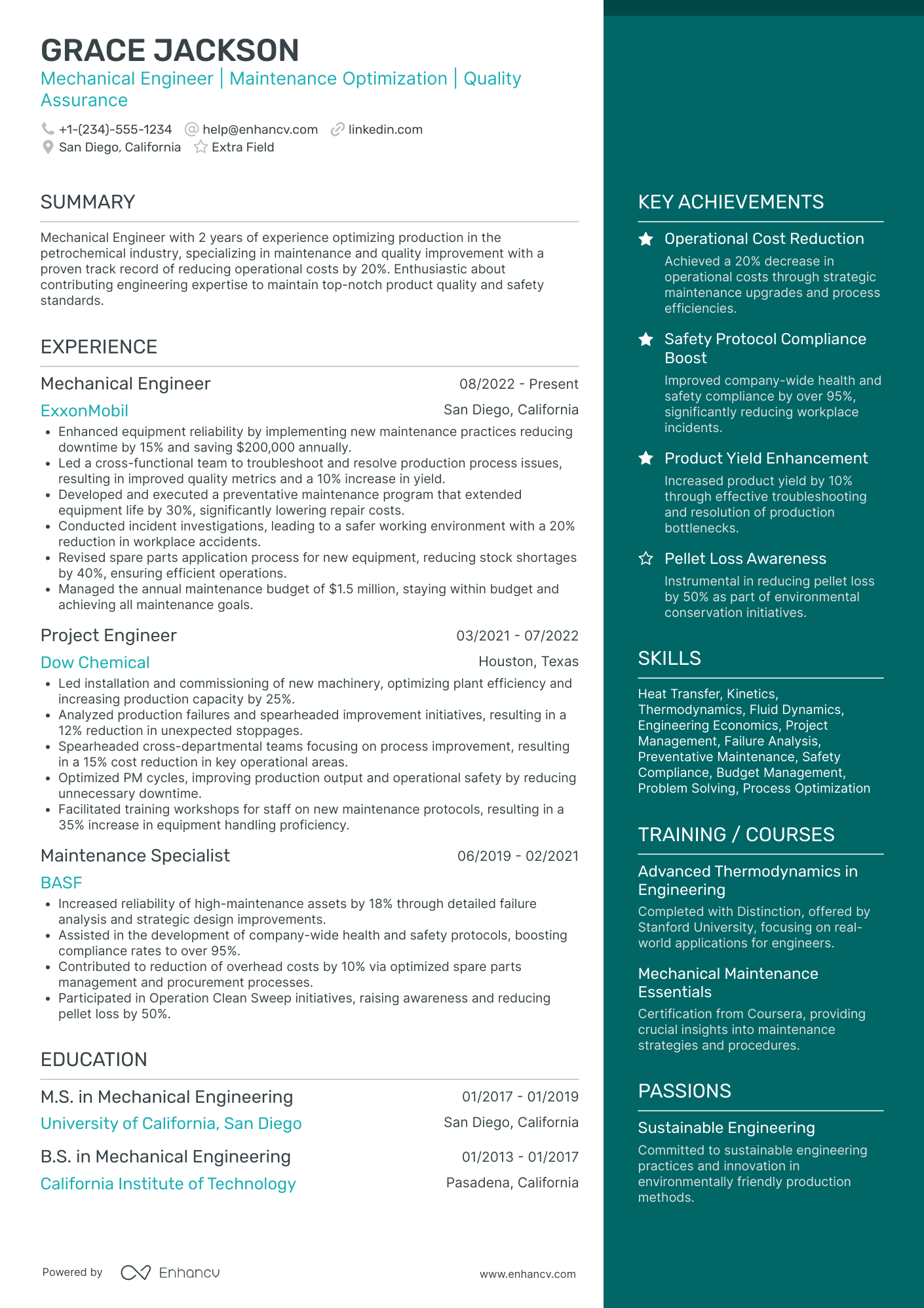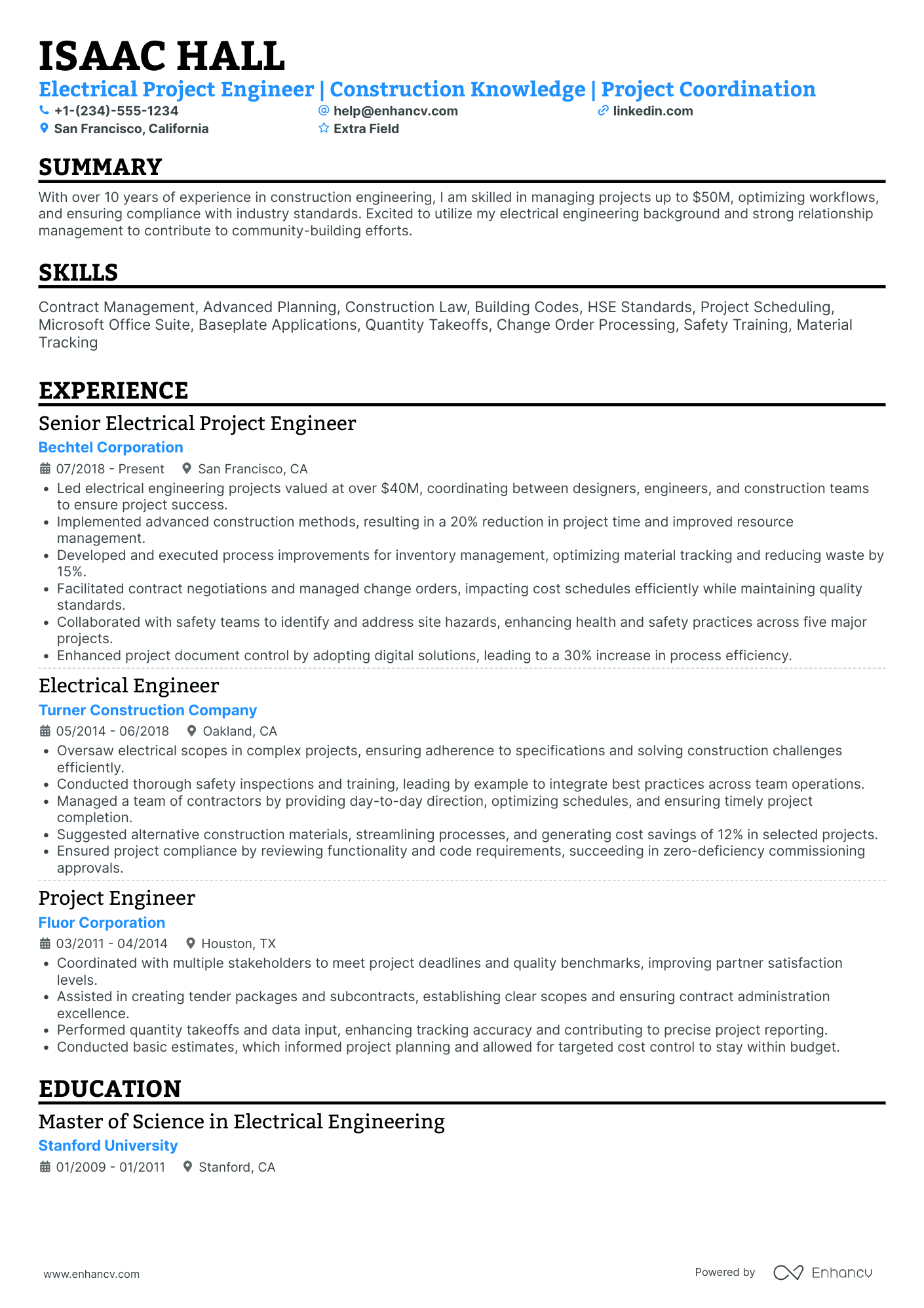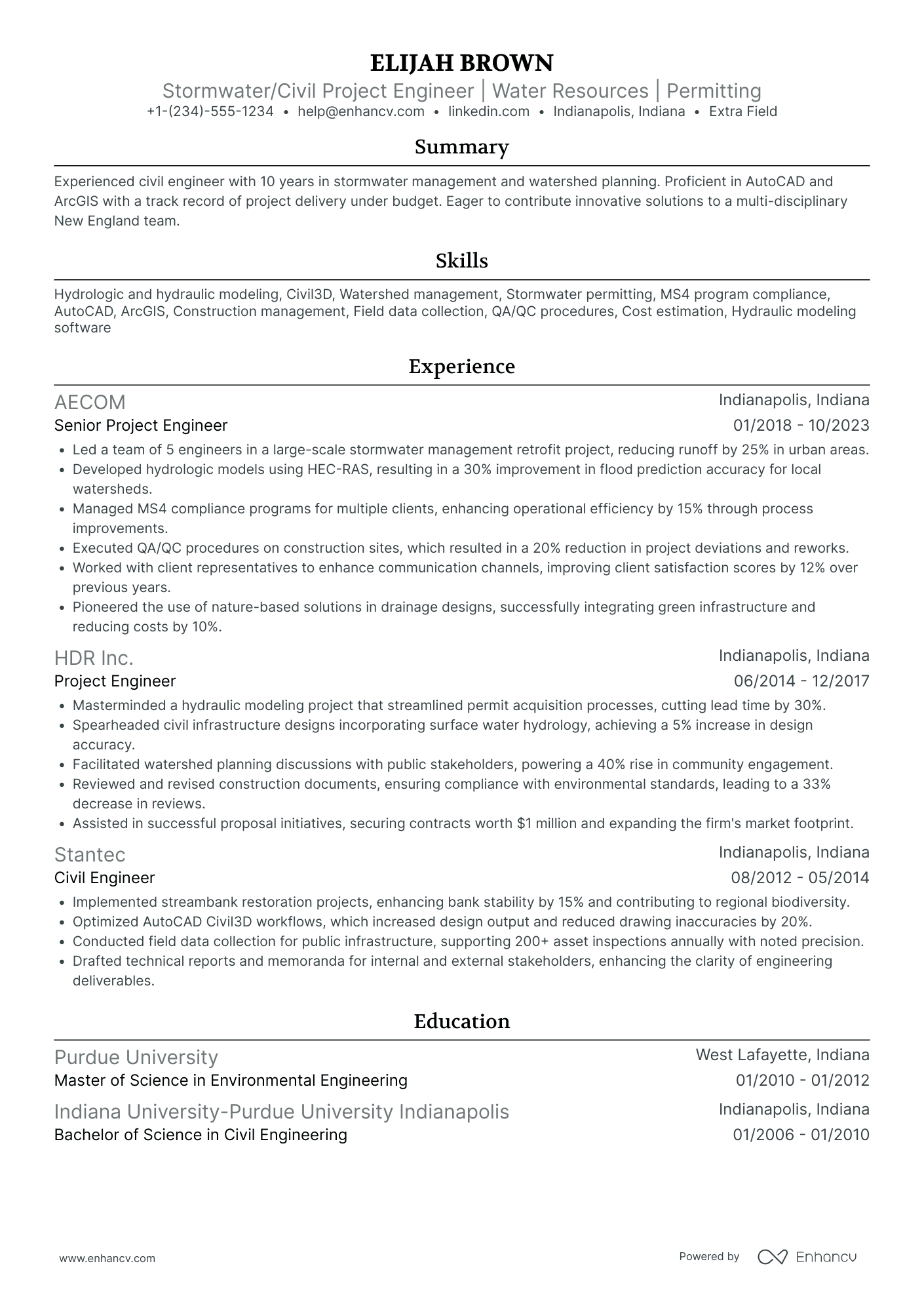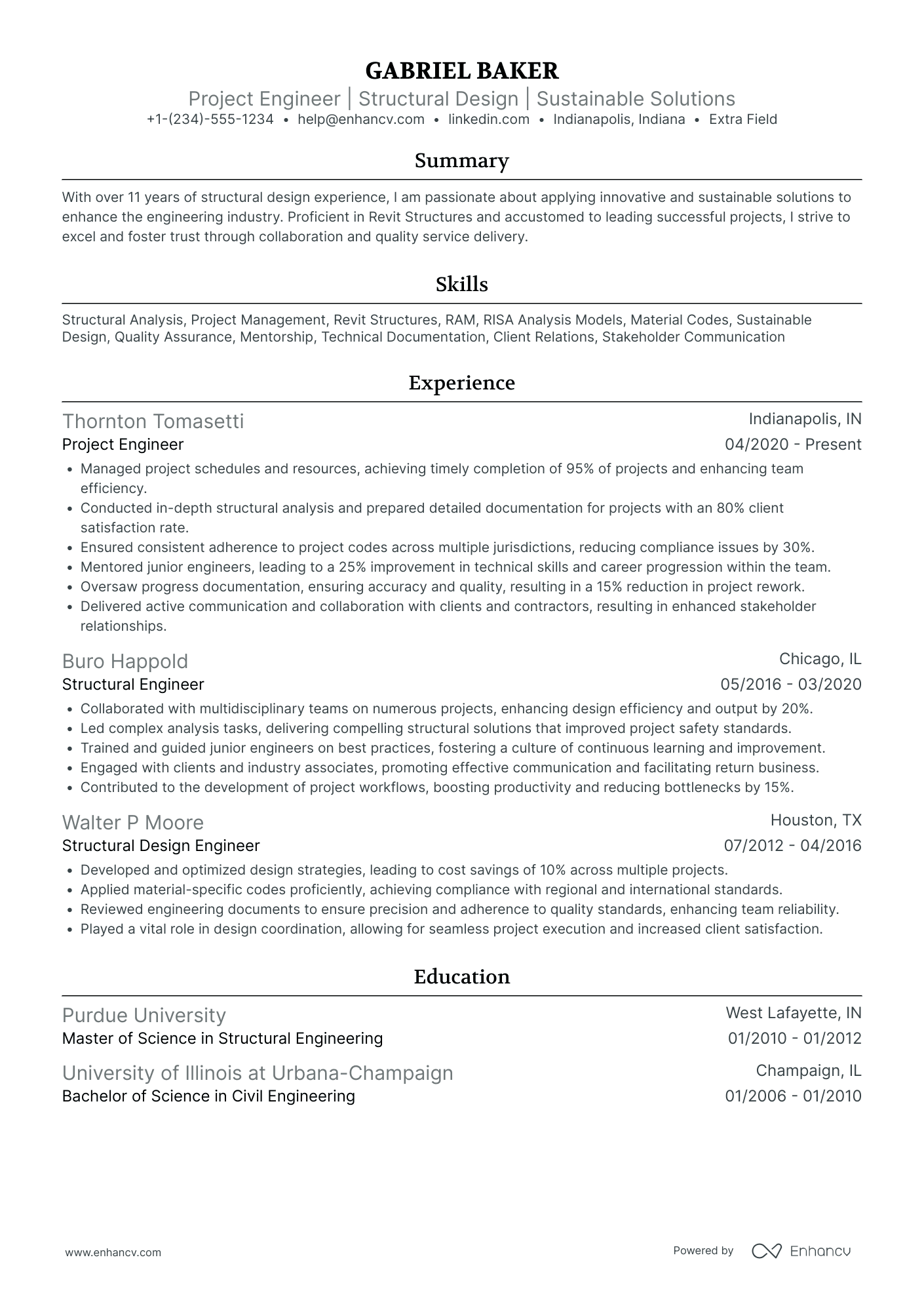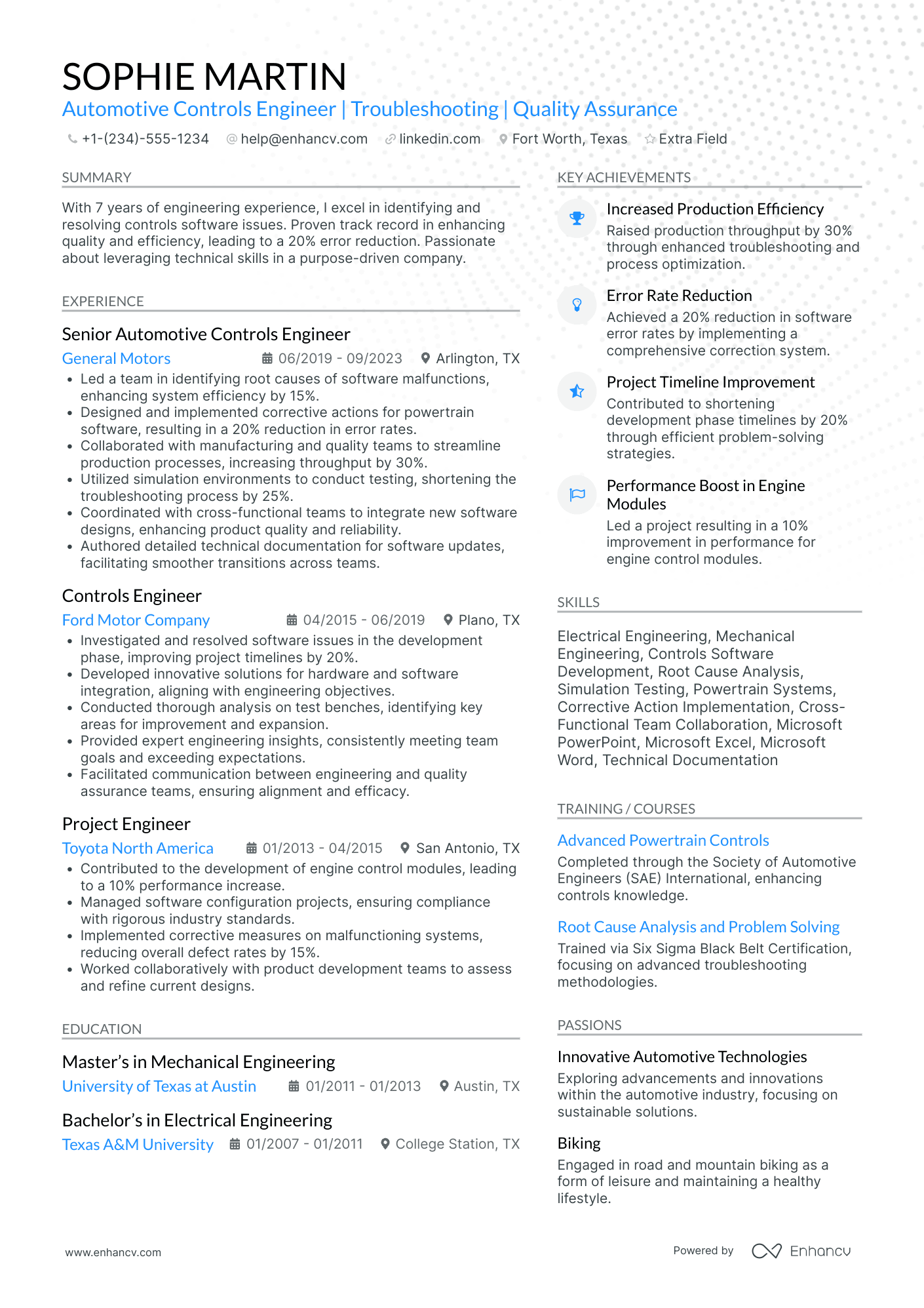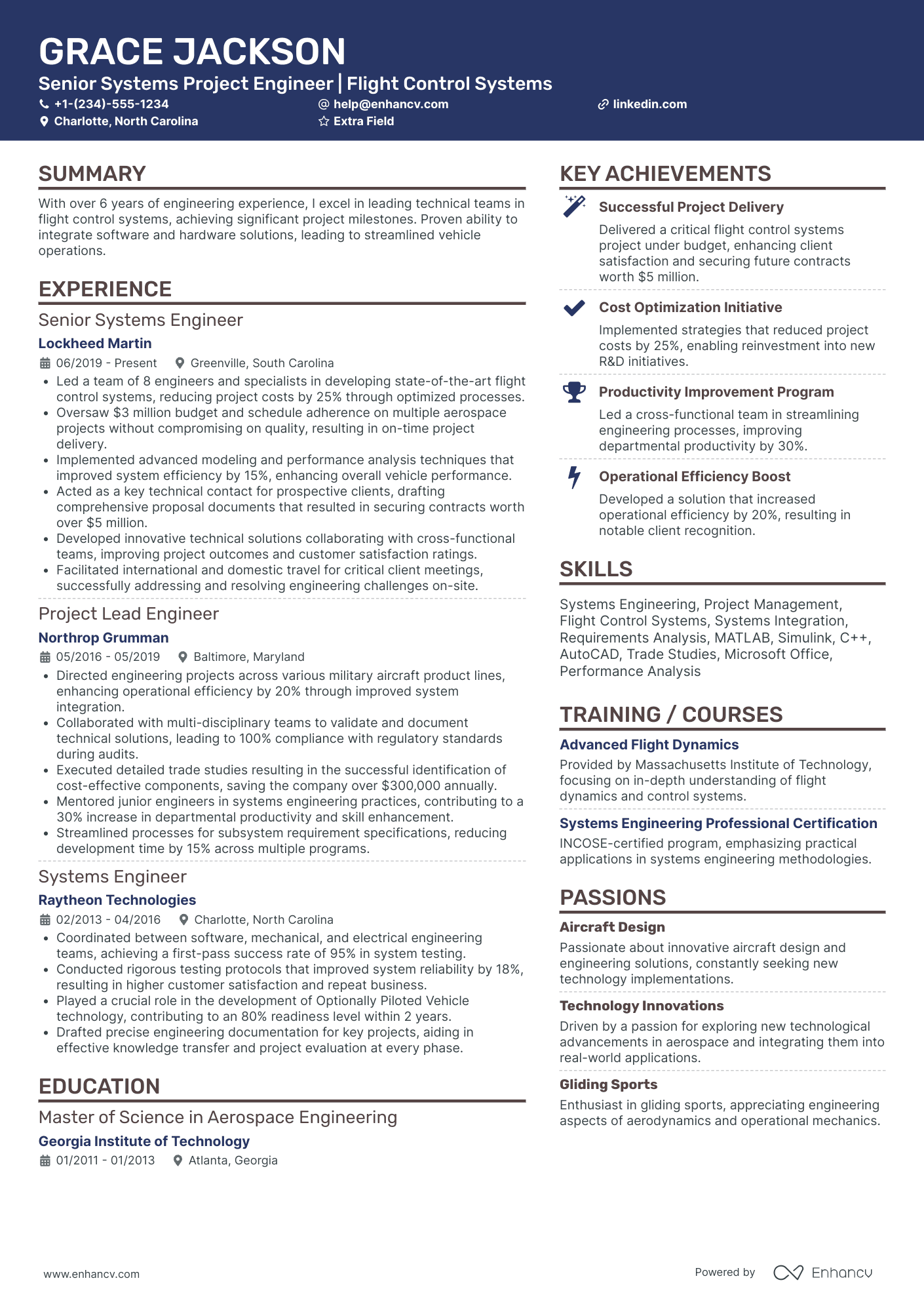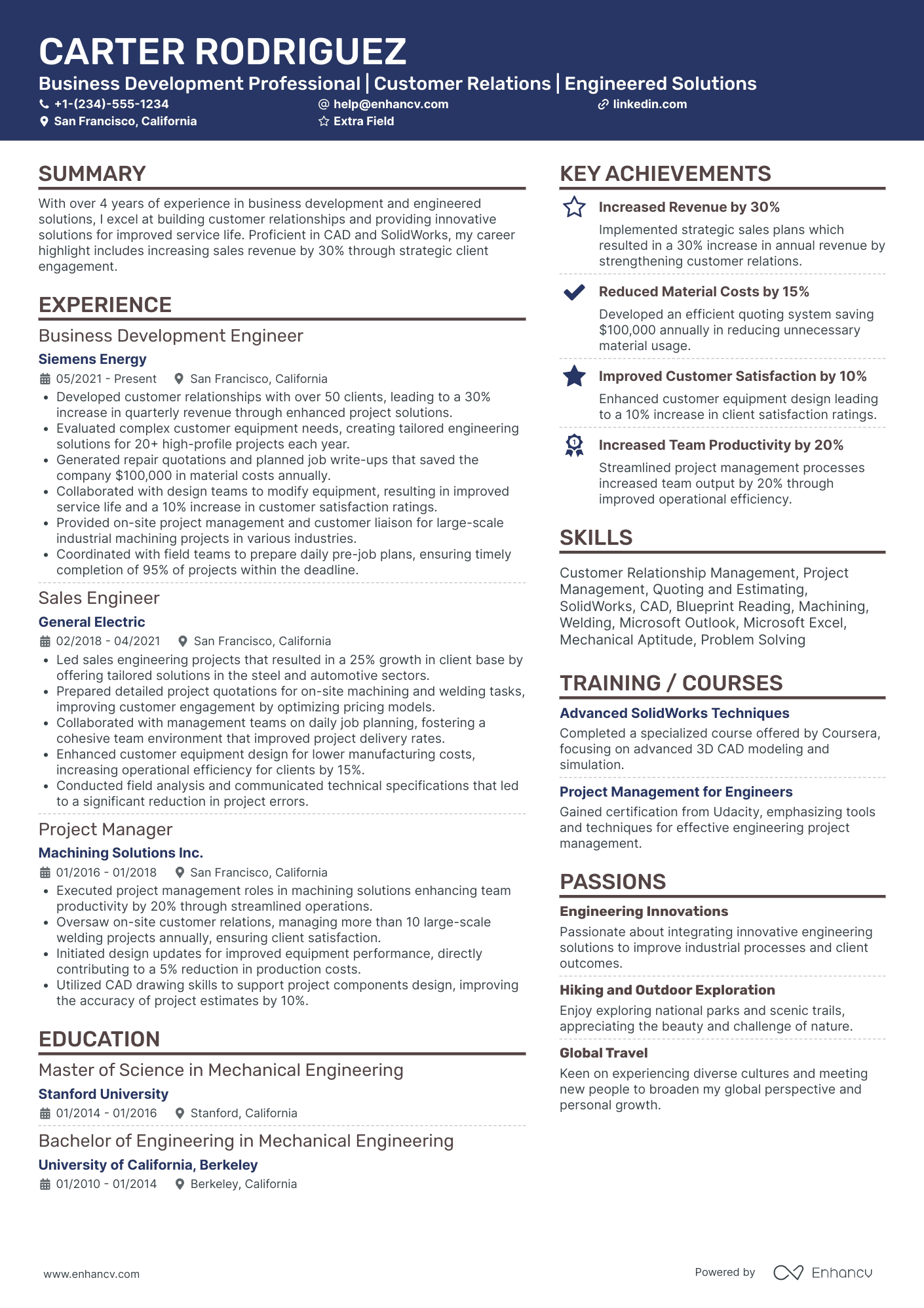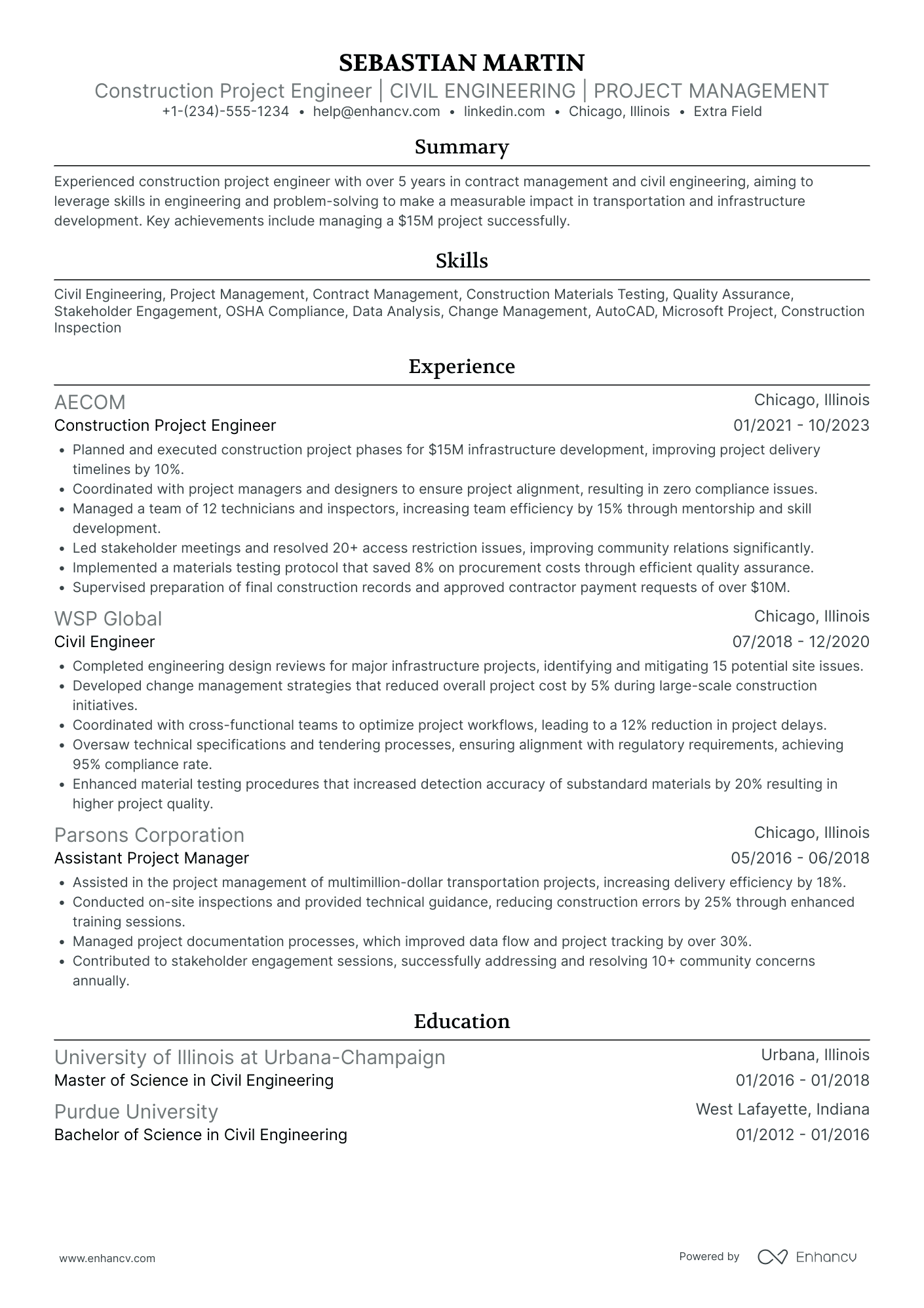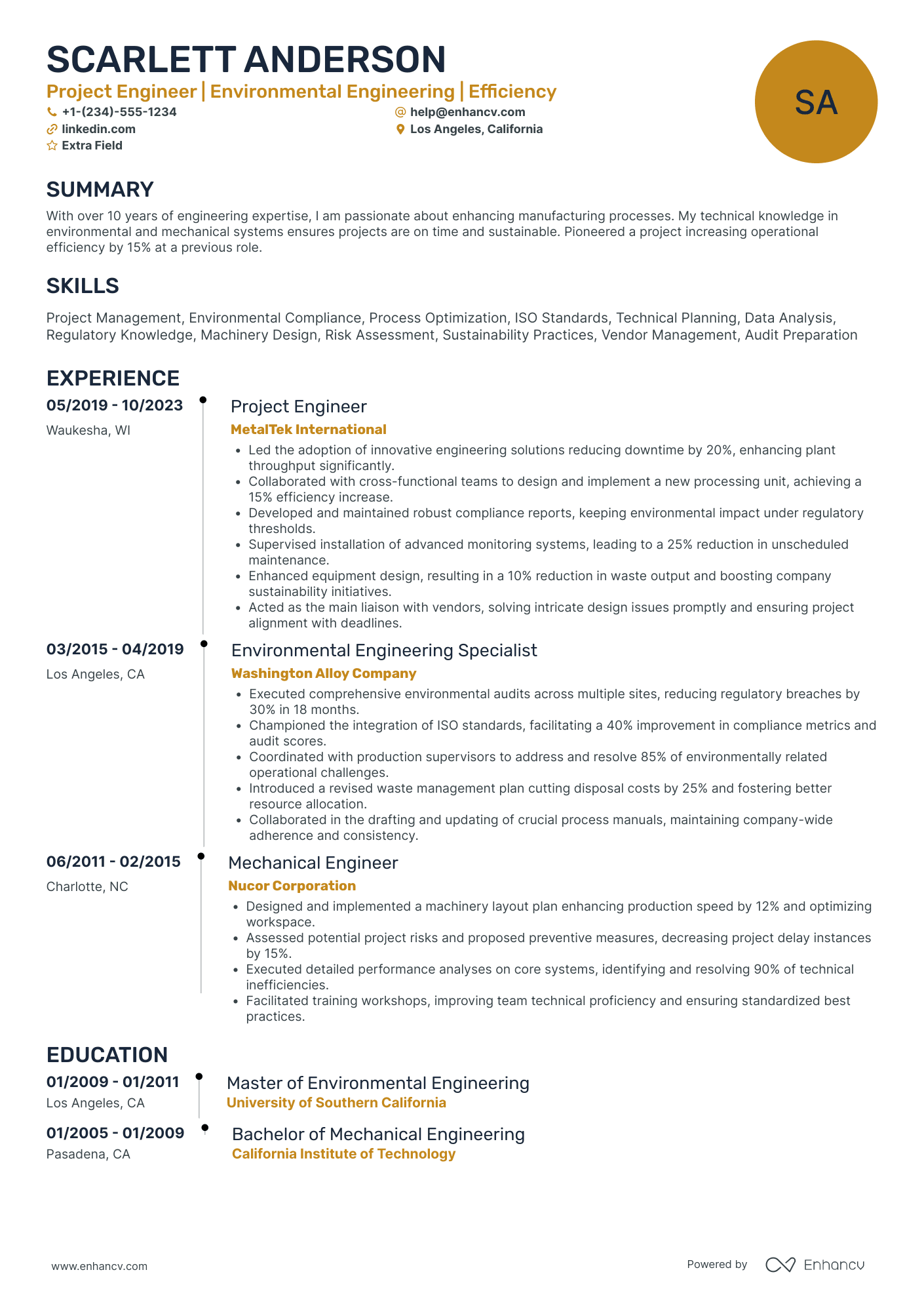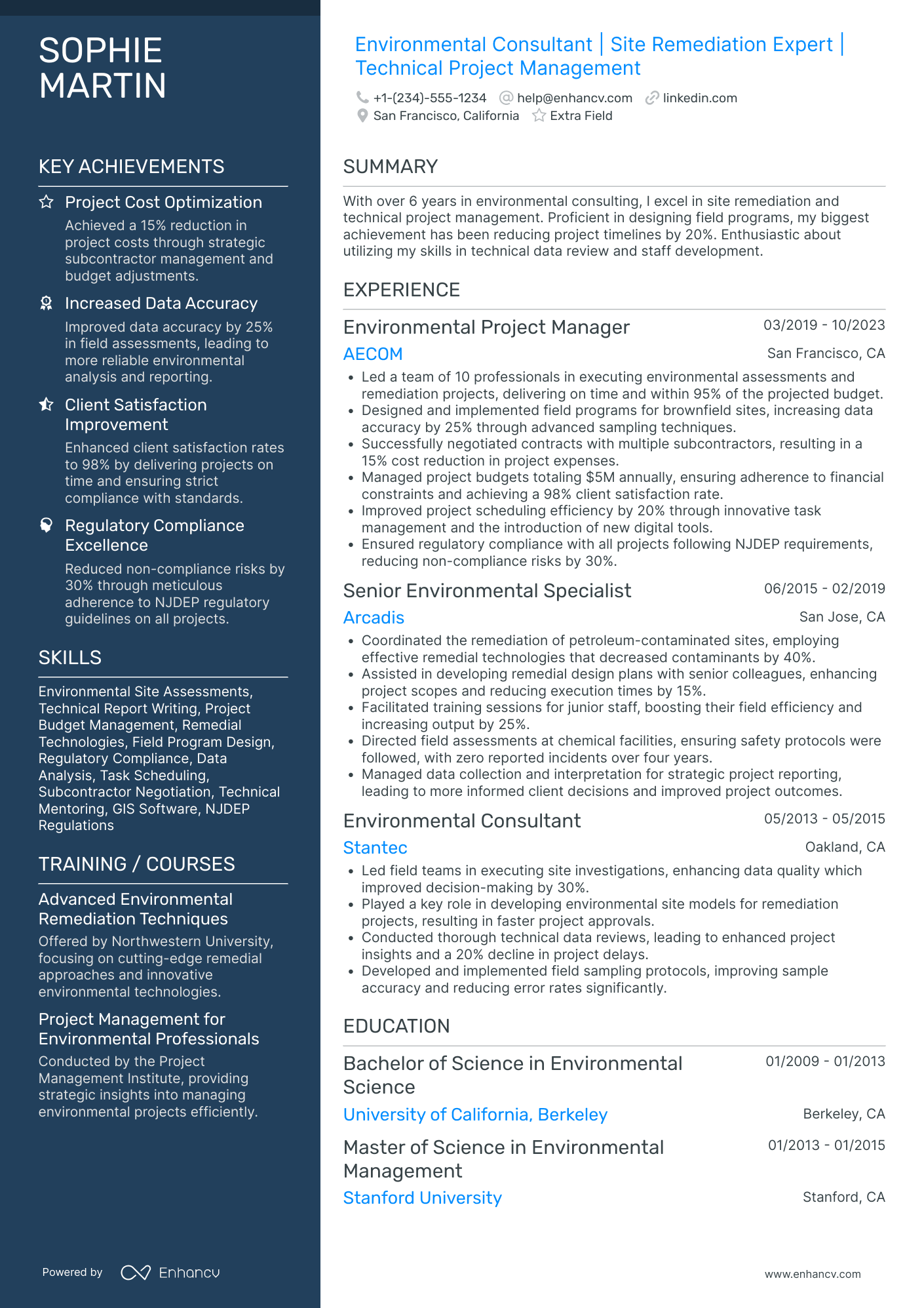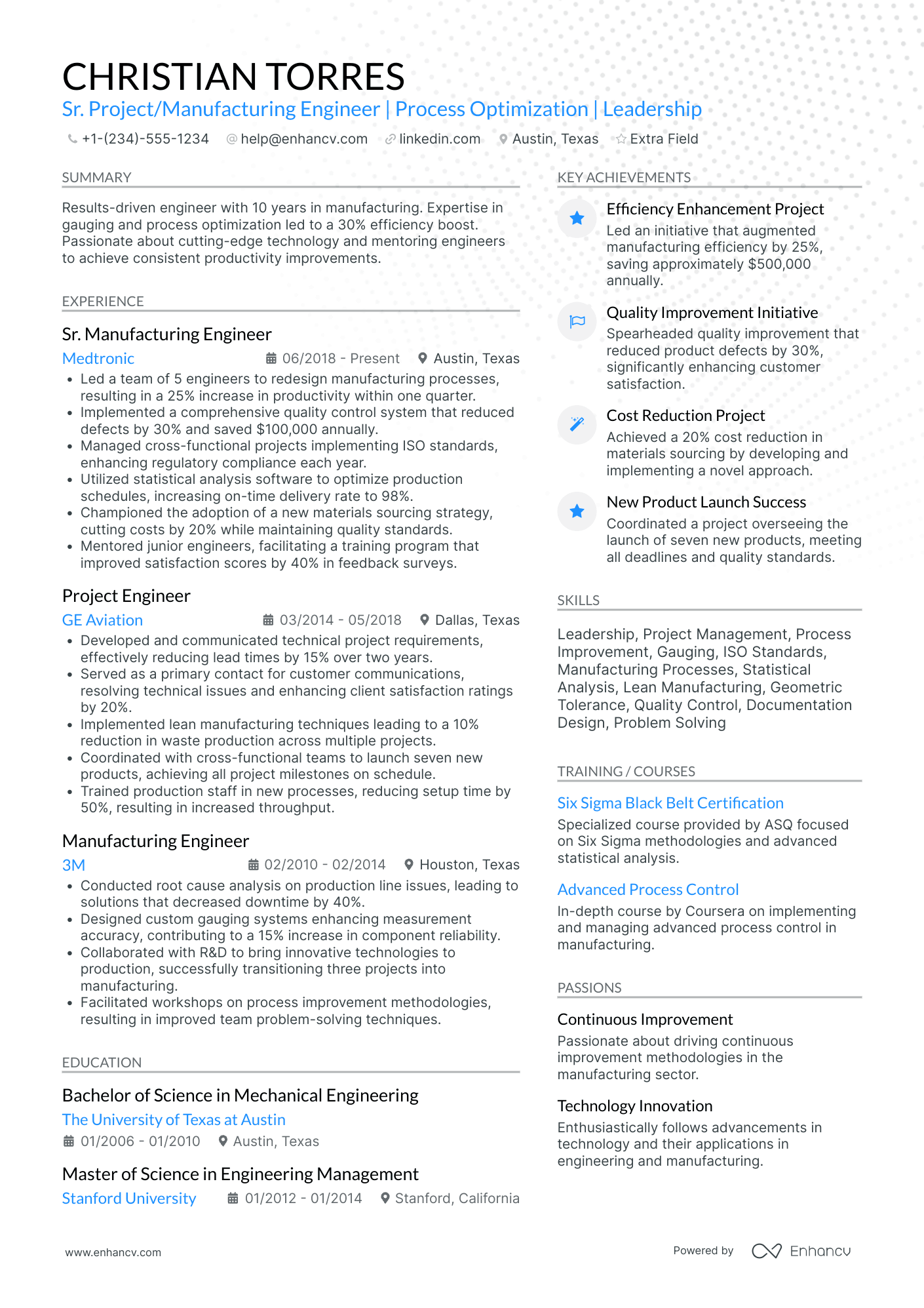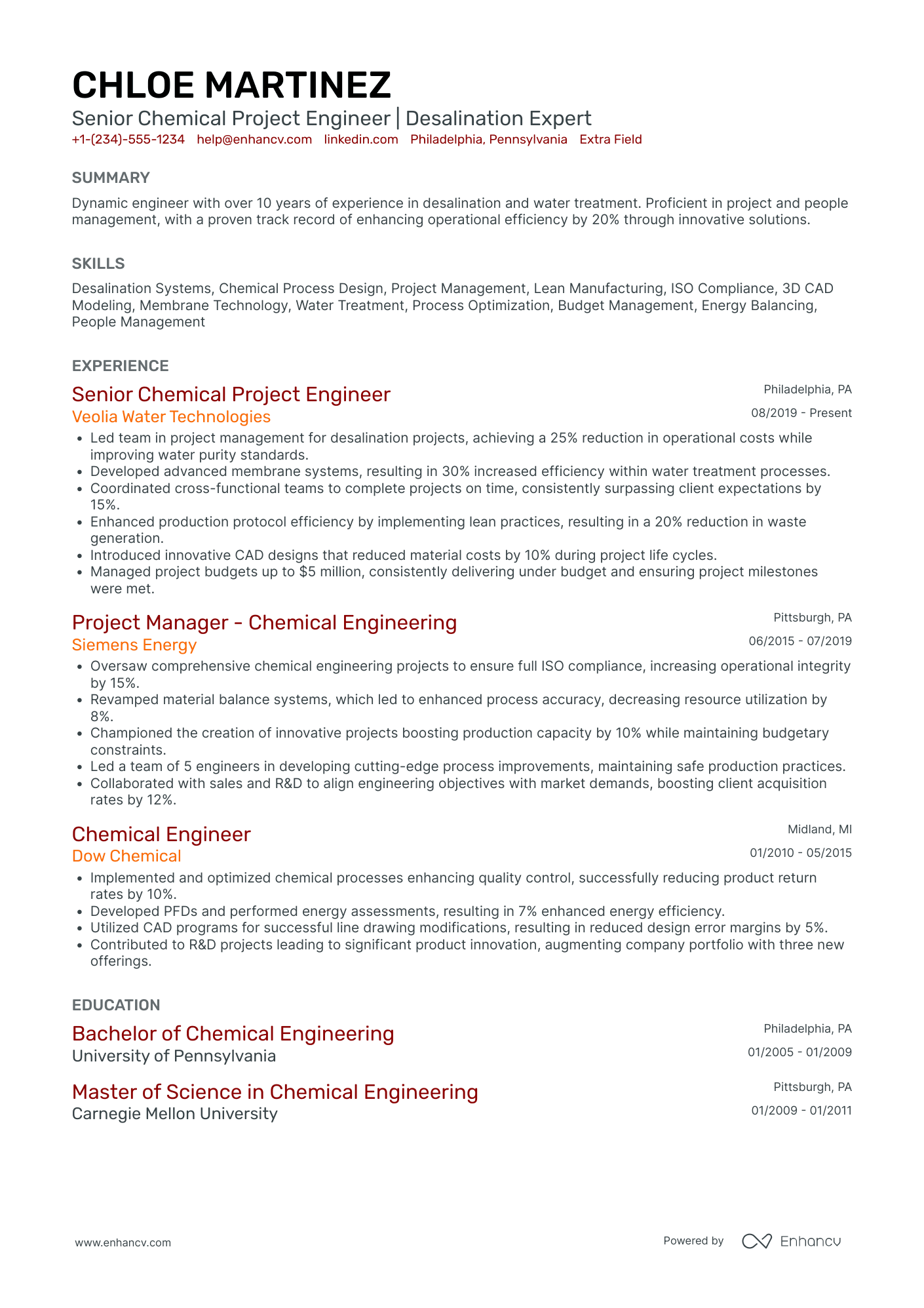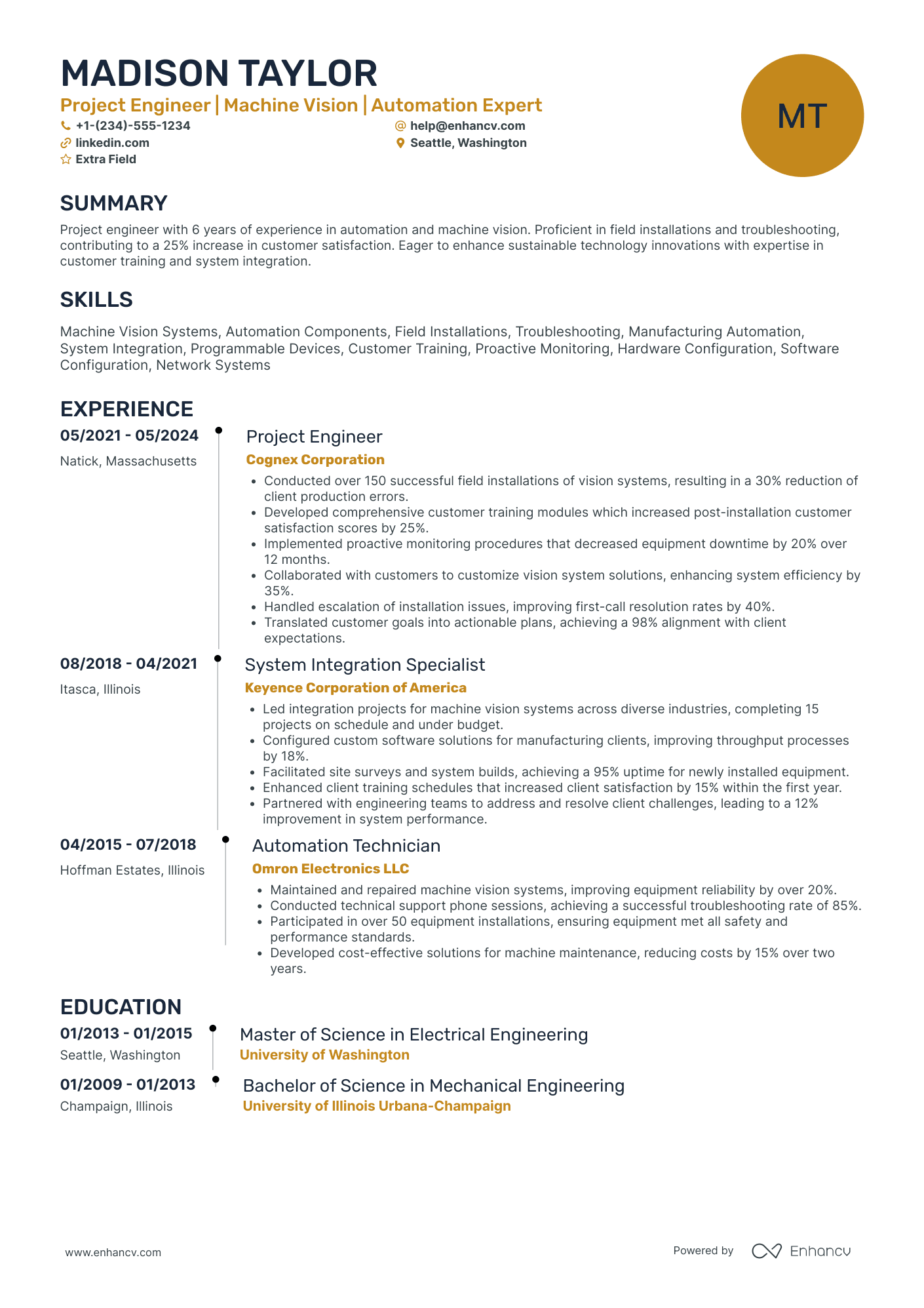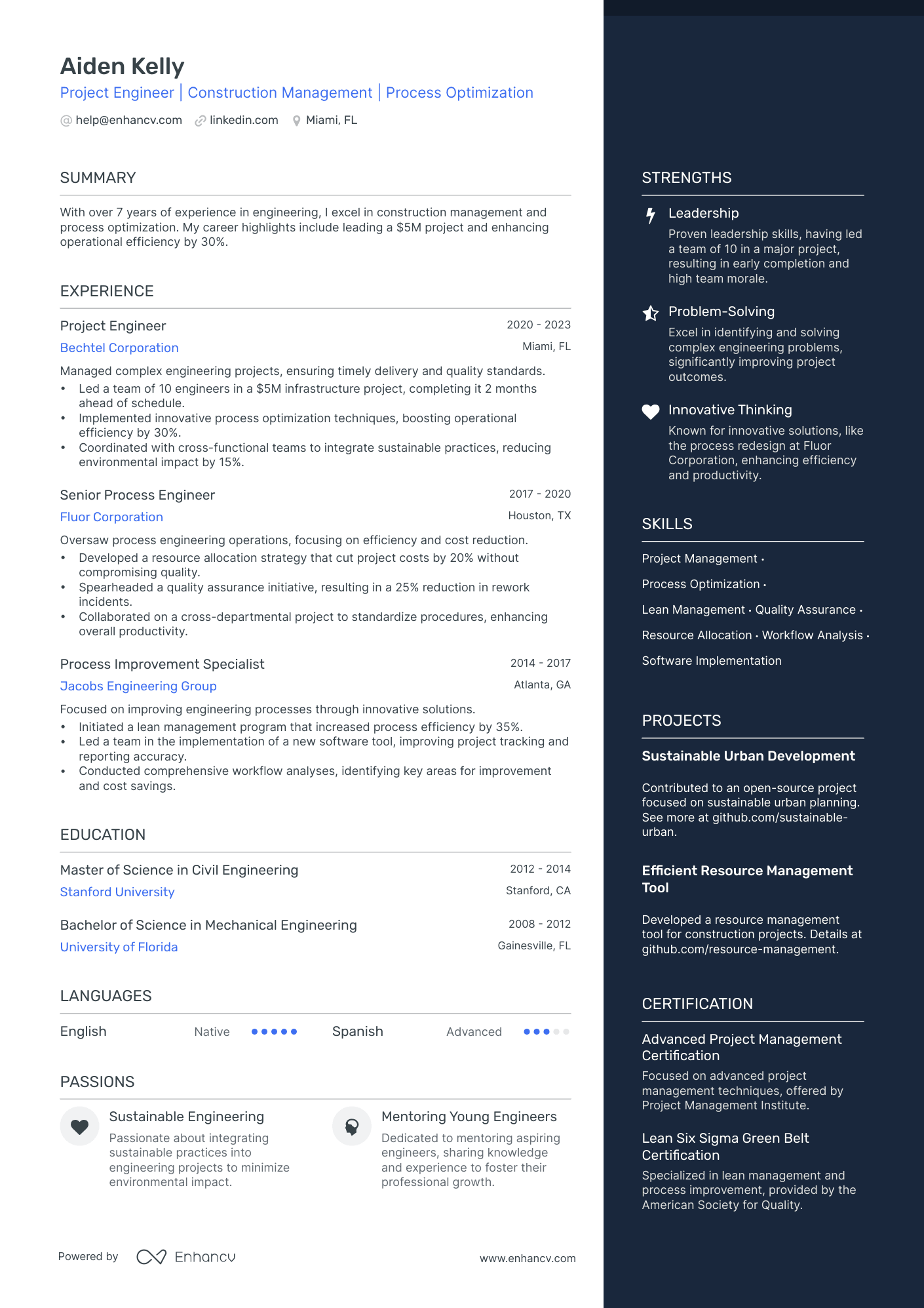As a project engineer, you know very well how to deal with people, how to think on your feet, and how to utilize your technical skills to get a project off the ground and completed in time.
Those are all incredibly valuable skills, but how do they translate into your resume? The perfect project engineer resume conveys the right balance between technical proficiency, industry-specific knowledge, and people management skills.
Seems complicated? Don’t worry, we have the exact know-how on how to create this perfect project engineer resume.
Read on to learn:
- What a good example of a project engineer resume looks like.
- How to structure and format your resume in a way that encompasses all the varying skills and experiences of a project engineer.
- Which sections to include, and which to omit.
- How to best describe your previous experience in a way that emphasizes your professional impact.
- How to write your project engineer resume if you have no previous such experience.
- What skills, education, and certifications to include to make you stand out.
Looking for resume guides for other similar positions? Try:
Project engineer resume example
Here’s what this applicant does well in their resume:
- Project management and leadership: Emphasizes Aiden's proven leadership and project management skills, as demonstrated by leading a team of 10 engineers in a $5M infrastructure project, and completing it ahead of schedule.
- Process optimization expertise: Highlights Aiden's expertise in process optimization, such as implementing innovative techniques that boosted operational efficiency by 30% and spearheading quality assurance initiatives leading to significant reductions in rework incidents.
- Certifications in project and process management: Showcases Aiden's relevant certifications, like the Advanced Project Management Certification from the Project Management Institute and the Lean Six Sigma Green Belt Certification from the American Society for Quality, which are directly applicable to his role and expertise in process improvement.
- Sustainability in engineering: Focuses on Aiden's passion and initiatives in sustainable engineering, which align with contemporary industry trends, and his experience in integrating sustainable practices to minimize environmental impact.
How to format a project engineer resume
The formatting of your project engineer resume is the first thing that the hiring manager will consciously, or subconsciously, notice. A well-formatted resume conveys professionalism, competence, and attention to detail above all else. All qualities you want your resume to emphasize.
Not to mention that more and more companies are using ATS (applicant tracking software) when recruiting. Some of the top industries relying on ATS are tech, green energy, and staff agencies. So as a project engineer, be it in construction, tech, or engineering, it’s important that your resume formatting is ATS-friendly.
Here’s how to get it right:
Use reverse chronological order
The reverse chronological resume format is where your latest job experience is listed at the top of your resume, followed by all the rest in reverse chronological order. Most of the time your latest experience will have also been as a project engineer, or in a similar role. Recruiters quickly screen for years of relevant job experience, and having it right at the top makes sure they don’t miss it.
Wondering how to land a job in project engineering without previous experience? Read on further down to find out.
Include a header
A header at the top of your resume is a must. This is where you add your contact information, including:
- A professional email (the “FirstName.LastName@provider” format is best)
- Your phone number (don’t forget to add the area code)
- Your city of residence (e.g. Oakland, CA, or Cambridge, UK)
- A link to your professional page if you have one (e.g. LinkedIn, professional website, or some other form of a professional digital portfolio, etc.)
This is also where you could add a professional photo of yourself. However, different rules apply depending on your location. Include a photo if you’re applying for a job in Europe, the Middle East, Africa, Asia, and South America. Do not include one if you’re applying in the USA, United Kingdom, or Ireland.
Keep it to a two-page maximum
It’s important to keep your resume short, so as not to lose the reader’s attention. Unfortunately, recruiters tend to spend only six to seven seconds on a resume, so you want to make yours as concise as possible. As a project engineer, you are sure to have many projects you’re proud of that you’d like to display. Still, it’s important to do that in the most flattering, short way possible.
Use a modern and ATS-friendly font
Use a sleek, clean, modern font such as Rubik, Lato, Montserrat, Raleway, Exo 2, or Volkhov. Using classics like Times New Roman or Ariel isn’t necessarily incorrect, but they are generally overused.
Overall all serif and sans-serif fonts are ATS-friendly, i.e. easily readable by applicant tracking software. Speaking of, if you’d like to learn more about the role of ATS in recruitment, you can read this study that we conducted.
Avoid any spelling mistakes
Having spelling or punctuation mistakes on your project engineer resume leaves a bad impression. After all, you’ll be expected to read and write lots of technical project documentation, not to mention all the formal communication with teammates, project leads, and investors. You want your resume to show your literacy and strong communication skills. So run your resume through a friend or two and a spell check software.
Save your resume as a PDF file
When done, save your resume as a PDF file. PDFs make sure all your formatting and alignments stay in place no matter what machine or software your resume is open on. They are also the most ATS-friendly file format.
Different markets have specific resume formats – a Canadian resume could vary in layout.
Is your resume good enough?
Drop your resume here or choose a file. PDF & DOCX only. Max 2MB file size.
The top sections on a project engineer resume:
- Professional summary: Showcases expertise and key achievements in project engineering.
- Technical skills: Highlights specific engineering tools and methodologies mastered.
- Project experience: Demonstrates real-world application of project engineering skills.
- Education and certifications: Details relevant degrees and professional qualifications.
- Leadership and teamwork: Reflects the ability to manage projects and collaborate effectively.
What recruiters want to see on your resume:
- Relevant project experience: Recruiters prioritize this to assess hands-on experience in managing engineering projects.
- Technical proficiency: Essential for ensuring the candidate can handle the specific engineering tools and software required.
- Problem-solving skills: Critical for a project engineer to effectively address and resolve project-related challenges.
- Leadership and team management: Important to demonstrate the ability to lead and coordinate project teams.
- Communication skills: Vital for effectively conveying project goals, updates, and issues to team members and stakeholders.
How to write your project engineer resume experience
Now let’s dive into your project engineer resume experience section. This is where you list your work history in the reverse chronological order we mentioned previously.
Here’s how to do that:
- Only list your job experiences that are relevant to the project engineer position you’re currently applying for. Applying for a job in construction? List any constriction experience. Applying for a job in tech engineering? List any experience in tech. And of course, always list any sort of experience where you were in charge of a project. What you want to avoid is listing jobs such as your lifeguard experience in your college years, or your internship at the local pet store. Despite being part of your work history, they are in no way relevant to your desired role and will only serve to fill up your resume pages and steer attention away from your project engineering experience.
- Note any promotions or changes in your seniority level over the years. The project engineer career ladder is a rather long one and can stretch through many levels along the way. Perhaps you worked at the same company for six years, always holding the official title of “project engineer”, even though you were unofficially promoted to Senior project engineer three years in. Perhaps at one job or another, you had all the responsibilities of a project engineer, but you were also given a leadership role parallel to that, making you a Team Lead. Make sure to show that in your Experience section. This is especially relevant if you’re applying for a senior-level project engineering job, or even an executive-level project engineering job. You want to show the recruiter reading your resume that you are indeed a relevant candidate for the job with years of senior-level experience.
- Use between four and six bullet points to describe each of your work history entries. Bullet points are easy to read and process. And any more than six would be adding unnecessary fluff to your resume.
- Don’t just list out your responsibilities at each previous job. Companies hiring for a project engineer already know what those job responsibilities are and that they more or less overlap across employers. List a job responsibility only if it is something very specific or even unusual for a project engineer. For example “Hired and led a team of subcontractors for a year.”
- Tailor your job history entries to the job ad you’re applying to. Use the same keywords they’ve used. This will help you stand out as a suitable candidate immediately, both to a recruiter, and ATS.
- List your accomplishments at each job. Focus on how you made an impact. It’s your accomplishments at each of your previous jobs that help you stand out. Not every project engineer handled big budgets or improved cost efficiency by a significant amount. And most of those who did, make the mistake of not listing them! Go against the grain and stand out immediately.
Here’s what to avoid when writing your Experience section:
- •Overseeing various projects from start to finish
- •Project planning, budget management, stakeholder management
- •Working with subcontractors
- •Using cutting-edge software
- •Worked on conducting studies
Here’s what’s wrong in this example:
- The example candidate more or less just lists their job responsibilities as a project engineer. “Overseeing projects and managing budgets and stakeholders” are all things a project engineer usually does, but they do not convey any significant impact the applicant has had in their job.
- The candidate uses vague language and doesn’t describe their unique experience and accomplishments:
- “Various projects” doesn’t say much about the size of the projects, or whether the budgets managed were big or small.
- “Working with subcontractors” doesn’t make it clear whether the candidate had a leadership role, whether they were in charge of recruitment, whether they worked with large or small teams, etc.
- “Using cutting-edge software” doesn’t specify what software, whether the candidate is proficient in it, or what impact the use of this software has made.
- “Worked on conducting studies”, again, doesn’t explain the level of involvement of the example applicant, what these studies were on, how they were relevant to their job as a project engineer, and what they’ve achieved through them.
This is all in contrast to this next example, which will show you what your Experience section entries should look like:
- •Oversaw a year-long $8M project
- •Managed teams of subcontractors
- •Implemented cutting-edge Lean Six Sigma friendly project management software, improving customer satisfaction rates by 115%
- •Conducted longitudinal study on cost efficiency, resulting in lowering costs across all company projects by up to 25%
Here’s what’s right in this example:
- The example candidate lists their job title as Senior project engineer, signifying that they held a high-level role, meaning richer experience and more responsibilities. This is especially relevant when applying for another senior-level role.
- The applicant has the same experience as shown in the wrong example, but they’re describing it in the context of their top achievements and contributions. This helps them stand out and seem twice as skilled and qualified as their wrong-example counterpart.
- They’re using specific examples and metrics to add weight to their achievements: “$8M project”, “Lean Six Sigma”, “improving customer satisfaction rates by 115%”, and “lowering costs across all company projects by up to 25%”.
How to quantify the impact on your resume
Speaking of your achievements throughout your career, the best way to showcase them is to quantify them.
Show the hiring manager how you made an impact at each of your previous project engineer jobs by using “evidence”. Anything that points out exactly how or how much you made a positive difference.
Usually, that means using clear and exact metrics - percentages, numbers, and any such measures relevant to your contributions to your employer’s success.
For example…
- Include the budget size of projects managed to demonstrate financial responsibility and capability.
- Mention the number of team members led to showcase leadership and team management skills.
- State the percentage of projects completed on time to highlight efficiency and time management.
- Quantify the cost savings achieved in projects to show your impact on profitability.
- Specify the scale of projects in terms of square footage or other units to indicate experience with large-scale projects.
- Report the number of successful project bids won to reflect competitive and persuasive skills.
- Detail the percentage increase in efficiency or productivity from your initiatives to show measurable improvements.
- Note the number of cross-functional teams you collaborated with to demonstrate versatility and teamwork.
How do I write a project engineer resume with no experience
Sure, writing a project engineer resume with no such previous experience can be tricky, but there is a right way of going about it that will get you an interview.
Emphasize other achievements and non-work experience, such as:
Education
When your relevant job experience is lacking, it’s important to show you’ve put effort into learning about the intricacies of becoming a project engineer.
Highlight whichever level of formal education you’ve achieved. Focus especially on degrees and classes relevant to your desired project engineer role. Ideally, you’ll have a diploma in Engineering, Construction, or Computer Science to display. Expand on your major classes, relevant papers, projects, and all relevant awards, acknowledgments, and extracurricular studies.
You can also include your GPA, but generally, as a rule of thumb, it’s only best to do so if it’s higher than 3.5 on a 4.0 scale.
Specialized classes, courses, training, etc.
Have any non-formal education relevant to project engineering? Add them to your Education section, or if they’re more prominent than your formal education, create a new section labeled “Additional Studies” or “Courses”. List any engineering classes, project management courses, or training in computer science or construction, etc.
Internships
Make sure to list any internship you've done or are doing at the moment (this goes in your Experience section). Ideally, you've done an apprenticeship with a Site Engineer, Engineering Technician, or Technical Officer, but anything that is even remotely relevant to project engineering will do. After all, recruiters want to see eager and initiative-taking candidates.
Volunteer work
Have you taken part in any volunteer work? Maybe you spent a summer building houses in Ghana, or you volunteered to teach a class in STEM for kids.
Add them to your Experience section, name the organization you worked with, and list some main responsibilities if they're relevant to project engineering.
Projects
You may not have had any professional experience as a project engineer yet, but you will have taken part in or even headed a project at one point or another.
This includes projects you've done in school, university, apprenticeships, as part of a coursework or certification exam, etc. It also includes projects you've done in your free time as long as they're at all relevant professionally. Maybe you developed an app that helps local sustainability NGOs, or you wrote a research paper on power plants.
Whatever it is, include it. With no experience, your various projects will help you stand out significantly.
Skills
Do list all your skills relevant to project engineering. These go in a separate Skills section. You may have acquired them during your education, or while working on personal projects, it doesn't matter - emphasize them! Let the recruiter know you have the skills it takes to start working as a project engineer.
Speaking of skills…
Focus on your transferable skills
If you have some previous work experience, other than as a project engineer, listing that can help too!
In reverse chronological order (starting with the latest) list your work experience. Under each entry include three to four bullet points of:
- Any responsibilities you've had at that job that can be related to project engineering.
- Any impressive achievements you've had, such as exceeding KPIs, being promoted to team lead, being put in charge of budget management, or anything else similar that would be beneficial experience for a project engineer.
These are your transferable skills. It's things you've worked on at jobs that weren't in project engineering, and the skills you’ve acquired along the way that, however, are very much sought after in a project engineer.
How to list your hard skills and soft skills on your resume
There are two types of professional skills you need to include in your resume - hard skills and soft skills.
Hard skills are tangible, specific skills usually gained through a course, a form of education, training, etc. These are your proficiencies in certain software, mechanics, engineering tools, etc.
Your soft skills are more people-focused and are usually personality traits like your communication skills, leadership, conflict resolution, task assignment, etc.
Here’s how to list your skills on your project engineer resume:
- Create a Skills section in your resume.
- Add your skills one by one.
- Make them as concise as possible. They’re supposed to be easy to spot and digest, not something that needs elaboration.
- Separate the hard skills from the soft ones for a more organized look.
- Focus on the skills relevant to project engineering. For example AutoCAD and Project Management. Even if you’re amazing at it, leave Video Editing out.
- List the skills you’re best at. If relevant, or if you’re barely starting in your career, you can also add skills you’re intermediate in. However, don’t add anything you’ve only heard of in passing. Employers will expect you to use the skills listed.
- Tailor your Skills section to the job ad you’re applying to.
Check out the requirements listed and add the same skills (that you possess of course) word for word. If the company is using ATS (applicant tracking software), it will match keywords from the job ad with your resume. You want to make your resume light up like a Christmas tree.
Not to mention that, much like ATS, recruiters are also used to quickly skimming resumes for the relevant keywords, and you want to stand out as a suitable candidate as quickly as possible.
This is a good rule of thumb to follow in general when writing your resume. If the job ad has phrased it as “project management” instead of “project managing”, then you should also use the same wording.
Best hard skills for your project engineer resume
- AutoCAD
- SolidWorks
- Project Management Software (e.g., Microsoft Project)
- Building Information Modeling (BIM)
- Computer-Aided Engineering (CAE) software
- MATLAB
- Lean Six Sigma methodologies
- Quality Assurance protocols
- Environmental compliance knowledge
- Construction management tools
- Electrical engineering principles
- Mechanical engineering principles
- Civil engineering software (e.g., Civil 3D)
- Structural analysis software
- Hydraulic engineering tools
- Geotechnical analysis software
- Cost estimation software
- Risk management frameworks
- Energy efficiency and sustainability practices
- Supply chain management systems
Best soft skills for your project engineer resume
- Leadership
- Team collaboration
- Problem-solving
- Time management
- Effective communication
- Adaptability
- Attention to detail
- Decision-making
- Critical thinking
- Conflict resolution
- Project planning
- Organizational skills
- Negotiation skills
- Risk assessment
- Creativity
- Customer focus
- Emotional intelligence
- Ethical judgment
- Patience
- Resilience
How to list your certifications and education on your resume
The education and certifications that project engineers have vary a lot depending on seniority level or exact field of work, but most recruiters expect to see a Bachelor’s degree listed.
So, starting with the highest level of formal education you’ve completed, list your degree(s) in your Education resume section, i.e. Ph.D. -> M.S. -> B.A. -> High School Degree.
Here’s how:
- Write the name of the degree.
- List the name of the school, college, or university.
- Add the location of the institution.
- Add the timeframe of attendance.
- Add major accomplishments or any project engineer-related practical experience.
- If you have a GPA higher than 3.5 on a 4.0 scale, add that too.
- Add any honors and awards if you have them.
- Add your capstone project or coursework if it’s relevant to project engineering.
- •Honors: Dean's List
- •Capstone project on Smart Traffic Lighting Systems
- •Headed a 10-people volunteering team in real life construction management project
Listing a high school degree? The same rules apply.
No formal education in project engineering? Add any relevant course, conference, training, etc. you’ve completed. List them much like the example above. Add the name of the course, the name of the organization that provided it, and any major projects, achievements, and practical experience gained.
Usually hiring managers for project engineers will also be looking for certifications in candidates’ resumes.
If you’ve gained any relevant certifications, here’s how to list them:
- Create a separate Certifications resume section.
- Similar to your Skills section, merely list your certificates by name one by one.
- List them in both abbreviated and full form. Some recruiters might not be aware of what PMP stands for, plus this way you’re making sure your Certifications section is ATS-friendly.
- Renew any expired certificates before adding them to your current resume.
- Stick to certificates relevant to project engineering. For example
Best certifications for your project engineer resume
How to write your project engineer resume summary or objective
One integral part of your resume is your Summary or Objective.
That’s the short paragraph at the beginning of your resume, usually right under your name and job title, briefly introducing and describing you as a professional.
It’s called (and formatted as) a Summary when it summarizes your career path thus far and your top skills and achievements.
It’s called (and formatted as) an Objective when it states your future career goal or objective.
Use a Summary if you have prior experience in project engineering. Use an Objective if you’re switching careers and applying to be a project engineer with no previous experience.
A good Summary…
- Describes your professional path in two to three sentences.
- Mentions your job title, mirroring the title of the job ad you’re applying to, e.g. “project engineer” / “project engineering Specialist”, etc.
- Includes your years of experience as a project engineer.
- Mentions your biggest one or two achievements and your top skills in the field.
- Uses numbers/examples to illustrate your contributions.
Avoid making mistakes such as the ones in the following example:
Here’s what’s wrong in this example:
- “Highly skilled and experienced” may as well be true for our example candidate, but it sounds too generic. It lacks exact years of experience.
- The applicant lists software relevant to project engineering, but that’s what the Skills section is for, not the Summary. It might be irrelevant to the employer what the candidate is currently working with, as they might use different software.
- It’s not clear if these three programs are something the applicant is highly skilled in or just something they’re obligated to use at their current job.
- “Experience in stakeholder management and project planning” is all well and good, but it is again very generic. It is what every project engineer does. The candidate should be focusing on what makes them stand out in their career as a project engineer, not repeating what their main responsibilities are.
Here’s how it should look:
Here’s what’s right in this example:
- Exact years of experience are mentioned. That way the recruiter will know in seconds that the example candidate is a fit for a senior project engineer role.
- It mentions that the applicant is a certified project engineer - this adds tangible evidence and value to their experience.
- It answers the recruiter’s main questions off the bat: what stages of project engineering does the candidate have experience with, what their top skills in the field are, and what their top achievements and contributions as a project engineer are.
- The candidate uses specific examples to illustrate their top achievements: “up to 20% revenue increase”, and “using Lean Six Sigma methods”.
And if you don’t have much or any experience at all as a project engineer, then opt for a resume Objective. Here’s how to write one:
- Keep it two to three sentences long.
- Mention your current job title/experience, but specify that your objective is to get into project engineering.
- Focus on your strongest transferable skills.
- Mention your biggest professional achievements, as long as they’re relevant to project engineering as well, e.g. improving cost efficiency or achieving high revenue growth while in charge of a project, etc.
For example
Optimize your resume summary and objective for ATS
Drop your resume here or choose a file.
PDF & DOCX only. Max 2MB file size.
Additional projects section for a project engineer resume
It’s not mandatory, but adding a separate Projects section to your resume might be a good idea for some.
Generally, you will have mentioned your biggest projects in the bullet points of your Experience section entries, but if you’re a project engineer, who has worked on many notable projects, it’s best to list them in their separate resume section.
Here’s how:
- List your projects one by one.
- Add their duration period either via dates (“09/2021 - 05/2022”) or descriptives (“6 months”, “2 years”).
- Focus on noteworthy projects, or projects you know are in the field of your desired employer, e.g. sustainability, environment, construction, etc.
- If a project is especially big and impactful, do mention your top contributions to it. Otherwise, keep it short and only list the project name and duration. Your top contributions belong in your Experience section most of all.
Key takeaways
And that’s a wrap!
By now you should know how to craft a killer project engineer resume that is sure to get you called in for interviews right away.
To recap, here’s what we covered:
- Format your project engineer resume reverse-chronologically, add your up-to-date contact information, consider whether relevant to add a photo, use spell-check, keep it up to two pages long, and save it as a PDF file.
- Include the following sections: Summary or Objective, Job Experience, Education, Skills, Certificates, and optionally Projects and Courses.
- Focus on your top achievements, skills, noteworthy projects, and your biggest contributions. Use examples to quantify this.
- If you have no previous experience as a project engineer, focus on your transferable skills and achievements from previous experiences or education.
- Tailor your project engineer resume to the job ad you’re applying to. Mirror the wording in the job title, skills, certifications, etc.
Project Engineer resume examples
By Experience
By Role
